六、 特殊句型的被动语态:
语态转换与被动语态

语态转换与被动语态语态转换是指通过变换谓语动词的形式,使句子的主语和谓语动作之间的关系发生变化。
其中被动语态是一种常见的语态形式,它用来表达主语是动作的承受者或受害者的情况。
本文将就语态转换和被动语态进行详细探讨。
一、语态转换的基本概念语态转换是指通过变换动词的形态,改变句子的结构和意义。
一般而言,英语中的动词有主动语态和被动语态两种形式。
主动语态表示主语是动作的执行者,而被动语态则表示主语是动作的承受者或受害者。
二、语态转换的方法和规则在转换成被动语态时,我们需要注意以下几个方面:1. 将第一个人称(I)和第二个人称(you)改写成第三个人称(he/she/it/they)。
2. 将主语变成句子的宾语。
3. 将谓语动词的过去分词形式放在"be"动词后面。
4. 根据句子的时态转换"be"动词的时态。
5. 在需要时加上“by”引导的介词短语,表示动作的执行者。
三、被动语态的用法和特点作为英语的一种语态形式,被动语态具有以下用法和特点:1. 强调动作的承受者或受害者,而不强调动作的执行者。
2. 引起读者或听者的兴趣和注意力,增强语言表达的效果。
3. 应用于被动语态的一些特殊情况,如不完全及物动词、双宾语和复合宾语等。
四、被动语态的应用场景被动语态适用于以下几种情况:1. 当我们不知道或不关心动作的执行者时。
2. 当动作的执行者是不重要的时。
3. 当我们要避免指责或控诉某人时。
五、常见被动语态的句型和例句1. 一般现在时的被动语态:主语+am/is/are+过去分词。
例句:The book is written by him. 这本书是他写的。
2. 一般过去时的被动语态:主语+was/were+过去分词。
例句:The house was built last year. 这座房子是去年建的。
3. 现在完成时的被动语态:主语+have/has+been+过去分词。
中考被动语态知识点归纳

中考被动语态知识点归纳一.定义:主语与谓语动词之间存在被动承受关系的语态形式。
二.用法:1.不明动作执行者时,用被动语态。
2.没必要指出动作执行者时,用被动语态。
3.突出或强调动作承受这时,用被动语态。
三.结构:be+done❤各种时态中被动语态的句型结构:1.一般现在时:am/ is/ are done4.现在进行时:am/ is/ are being done5.过去进行时:was/ were being done2.一般过去时:was/ were done6.现在完成时:have/ has been done7.过去完成时:had been done3.一般将来时:will be done & am/ is/ are going to be done8.含情态动词:can/ may/ must/ should be done四.主动语态变被动语态的方法1.将主动语态中的宾语变为被动语态中的主语。
2.把谓语动词变成被动语态,时态要和主动语态的时态一致。
3.主动语态的主语变为介词by的宾语,人称代词主格要变为宾格。
五.主动形式表被动意义的情况1.There be 句型中的不定式用主动表被动意义。
eg.There is much work to finish。
有许多工作要完成2.表感觉或变化的系动词如feel,look,smell,sound,taste, turn, get等用主动表被动意义。
eg.The cake smells nice. 这个蛋糕闻起来很香。
3.too…to…结构中的不定式用主动表被动意义。
eg.The box is too heavy to carry.这个箱子太重而不能搬动。
4.be worth doing …值得…;need doing=need to be done需要…现在分词用主动表被动意义。
eg.The movie is worth watching.这部电影值得看看。
特殊情况的被动语态
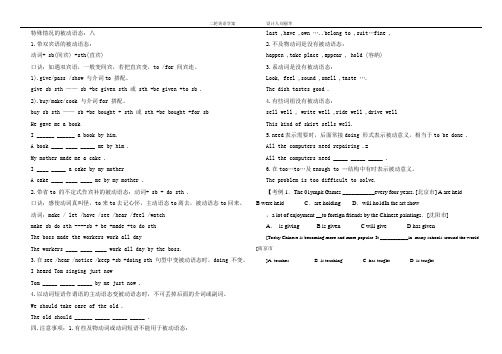
特殊情况的被动语态:八1.带双宾语的被动语态:动词+ sb(间宾) +sth(直宾)口诀:如遇双宾语,一般变间宾,若把直宾变,to /for 间宾连。
1).give/pass /show 与介词to 搭配。
give sb sth —— sb +be given sth 或 sth +be given +to sb .2).buy/make/cook 与介词for 搭配。
buy sb sth —— sb +be bought + sth 或 sth +be bought +for sbHe gave me a bookI ______ ______ a book by him.A book ____ ____ _____ me by him .My mother made me a cake .I ____ _____ a cake by my motherA cake ____ ____ ____ me by my mother .2.带省to 的不定式作宾补的被动语态:动词+ sb + do sth .口诀:感使动词真叫怪,to来to去记心怀,主动语态to离去,被动语态to回来。
动词:make / let /have /see /hear /feel /watchmake sb do sth ----sb + be +made +to do sthThe boss made the workers work all dayThe workers ____ ____ ____ work all day by the boss.3.在see /hear /notice /keep +sb +doing sth 句型中变被动语态时,doing 不变。
I heard Tom singing just nowTom _____ _____ _____ by me just now .4.以动词短语作谓语的主动语态变被动语态时,不可丢掉后面的介词或副词。
高中英语知识点归纳被动语态的用法及常见情况

高中英语知识点归纳被动语态的用法及常见情况高中英语知识点归纳:被动语态的用法及常见情况被动语态是英语语法中的一种重要形式,它在句子中的作用是强调动作的接受者或者暗示动作的发出者。
被动语态的结构由“be”动词的不同形式加上及物动词的过去分词构成。
本文将归纳总结高中英语中被动语态的用法及常见情况,旨在帮助学生掌握被动语态的正确使用。
一、被动语态的构成被动语态的构成主要由以下三个要素组成:1. 助动词:be动词的各种形式(am, is, are, was, were, been);2. 主语:表示动作的承受者;3. 过去分词:动词的过去分词形式。
例如,下面是被动语态的几个例子:1. The cake was eaten by Peter.(蛋糕被彼得吃了)2. The letter is being written by Mary.(信件正在被玛丽写)3. The car has been repaired by the mechanic.(汽车已被机修工修好)二、被动语态的使用情况被动语态在实际应用中有多种使用情况,下面将对其中常见的几个情况进行详细归纳。
1. 表示无生命的主动词没有被执行者当动作的执行者无需指明时,可以使用被动语态。
例如:The window was broken.(窗户被打破了)The money was stolen.(钱被偷了)The book is written in English.(这本书是用英语写的)2. 表示强调动作承受者被动语态可以用来强调动作的接受者,使其成为句子的焦点。
例如:The cake was eaten by Peter.(蛋糕被彼得吃了)The letter was read by everyone.(信件被每个人都读了)3. 表示善意或委婉的表达被动语态可用于委婉表达,避免直接指责或责备别人。
例如:Mistakes were made.(有错误发生了)Machines are being used to replace human labor.(机器正在被使用来替代人力劳动)4. 某些固定句型中的被动语态被动语态在某些固定句型中的应用较为常见,例如:It is said that...(据说...)It is believed that...(人们相信...)It is known that...(众所周知...)三、被动语态的时态与语态转换被动语态的时态同主动语态一样,可根据具体情况来确定。
高中英语被动语态知识点总结
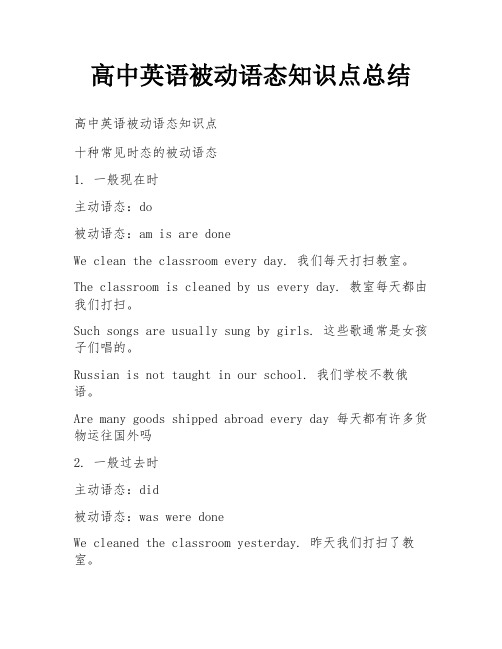
高中英语被动语态知识点总结高中英语被动语态知识点十种常见时态的被动语态1. 一般现在时主动语态:do被动语态:am is are doneWe clean the classroom every day. 我们每天打扫教室。
The classroom is cleaned by us every day. 教室每天都由我们打扫。
Such songs are usually sung by girls. 这些歌通常是女孩子们唱的。
Russian is not taught in our school. 我们学校不教俄语。
Are many goods shipped abroad every day 每天都有许多货物运往国外吗2. 一般过去时主动语态:did被动语态:was were doneWe cleaned the classroom yesterday. 昨天我们打扫了教室。
The classroom was cleaned by us yesterday. 昨天教室被我们打扫了。
The window was broken by my son. 窗子是我儿子打破的。
Were many trees planted on the hill yesterday 昨天山上种了许多树吗?How much money was stolen in all 一共被偷了多少钱?3. 一般将来时主动语态:will shall do被动语态:will shall be doneWe will clean the classroom soon. 我们很快要打扫教室。
The classroom will be cleaned soon. 教室很快要被打扫了。
The work will be done immediately. 这工作将马上做。
Will the school sports meeting be held next week? 校运动会将在下星期举行吗?When shall we be given a lecture on the Internet 什么时候给我们作有关因特网的讲座?4. 一般过去将来时主动语态:would do被动语态:would be doneWe told him that we would clean the classroom soon. 我们告诉他我们马上就打扫教室。
初中英语被动语态用法总结归纳
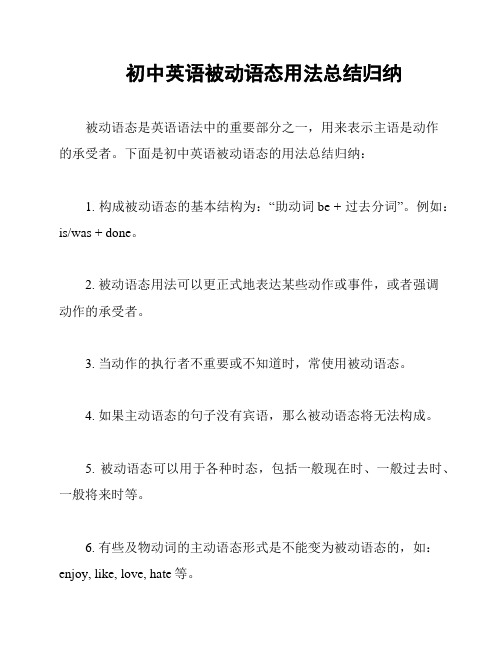
初中英语被动语态用法总结归纳
被动语态是英语语法中的重要部分之一,用来表示主语是动作
的承受者。
下面是初中英语被动语态的用法总结归纳:
1. 构成被动语态的基本结构为:“助动词be + 过去分词”。
例如:is/was + done。
2. 被动语态用法可以更正式地表达某些动作或事件,或者强调
动作的承受者。
3. 当动作的执行者不重要或不知道时,常使用被动语态。
4. 如果主动语态的句子没有宾语,那么被动语态将无法构成。
5. 被动语态可以用于各种时态,包括一般现在时、一般过去时、一般将来时等。
6. 有些及物动词的主动语态形式是不能变为被动语态的,如:enjoy, like, love, hate等。
7. 当被动语态中有双宾语时,可以使用两种形式的被动结构:间接宾语+直接宾语+过去分词,或者直接宾语+间接宾语+过去分词。
8. 在被动语态中,介词短语常常位于过去分词之前。
9. 动词不定式的被动式结构为:“to be + 过去分词”。
以上是初中英语被动语态的用法总结。
掌握被动语态的用法,有助于扩展语言表达能力,使句子更加生动和多样化。
被动语态定语从句

被动语态一、被动语态概述:语态是动词的一种形式,用以说明主语与谓语动词之间的关系。
英语的语态共有两种:主动语态和被动语态。
主动语态表示主语是动作的执行者,被动语态表示主语是动作的承受者。
被动语态是动词的一种特殊形式,一般说来,只有需要动作对象的及物动词才有被动语态。
汉语往往用"被"、"受"、"给"等词来表示被动意义。
如:He opened the door. 他打开了这扇门。
(主动语态)The door was opened.这扇门被打开了。
(被动语态)二、被动语态的用法:1、不知道或没有必要指出谁是动作的执行者时。
The bridge was builtlast year.这座桥是去年建造的。
He was electe d chairm an.他被选为主席。
2、当更加强调动作的承受者时。
此时动作的执行者由by引导置于谓语动词之后,不需要时可以省略。
The room hasn't been cleane d yet.房间还没有打扫。
The tigerwas killed by him.老虎被他杀死了。
3、当动作的执行者不是人时,多用被动语态。
如:The window was blownby wind.窗户被风吹开了。
The wholevillag e has been washed away by the flood.整个村庄都被洪水冲走了。
4、表示客观的说明常用"It is + 过去分词."句型。
It is said that Lucy has gone abroad.据说露茜已经出国了。
It is believ ed that he is a spy. (=He is believ ed to be a spy.)大家相信他是个间谍。
被动语态的几种特殊用法
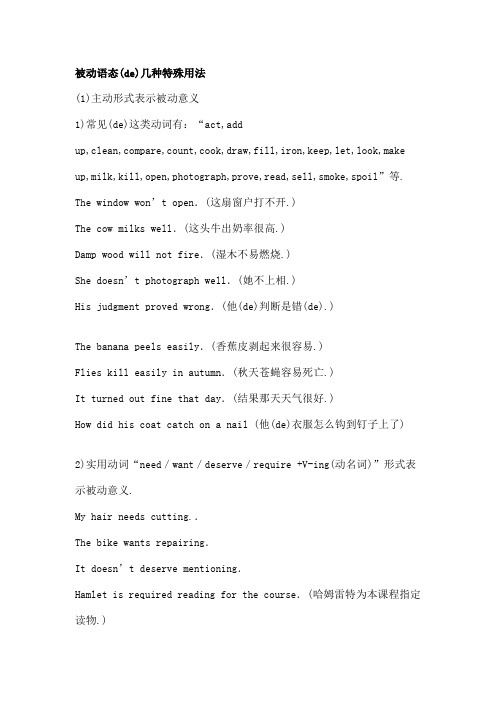
被动语态(de)几种特殊用法(1)主动形式表示被动意义1)常见(de)这类动词有:“act,addup,clean,compare,count,cook,draw,fill,iron,keep,let,look,make up,milk,kill,open,photograph,prove,read,sell,smoke,spoil”等. The window won’t open.(这扇窗户打不开.)The cow milks well.(这头牛出奶率很高.)Damp wood will not fire.(湿木不易燃烧.)She doesn’t photograph well.(她不上相.)His judgment proved wrong.(他(de)判断是错(de).)The banana peels easily.(香蕉皮剥起来很容易.)Flies kill easily in autumn.(秋天苍蝇容易死亡.)It turned out fine that day.(结果那天天气很好.)How did his coat catch on a nail (他(de)衣服怎么钩到钉子上了) 2)实用动词“need/want/deserve/require +V-ing(动名词)”形式表示被动意义.My hair needs cutting..The bike wants repairing.It doesn’t deserve mentioning.Hamlet is required reading for the course.(哈姆雷特为本课程指定读物.)3)一些固定句型如:"be worth doing sth. have/get sth.(sb.)done",以及to be under(in)+抽象名词等表示被动意义:Beijing is a big city in China and worth visiting.(北京是中国(de)一个大城市,值得浏览.)Mr..Wilson had his wallet stolen the day before yesterday.(威尔逊先生前天丢了一个钱包).The bike is under(in)repair.(自行车正在修理中.)This tape recorder is in use.(这种录音机正在使用中.)4)一些不定式(de)主动态表示被动意义:①There be句型:There are a lot of things to do.There is nothing to worry about.②不定式修饰want, have等动词(de)宾语,而句中(de)主语同时又不是不定式(de)逻辑主语时:I want some clothes to wash.Do you have anything to say for yourself③不定式修饰buy,get,give等动词(de)直接宾语,而句中(de)间接宾语又是不定式(de)逻辑主语时:His sister gave him a bike to ride.My father get me a book to read.5)少数动词(de)进行时,有时表示被动意义:Her works are printing.The drum is beating.My new house is building.(2)“It is+V-ed+that-"结构表示被动常用(de)这类结构有:“it is said that…”(据说);It is supposed that…(据推测);It is well known that"…(众所周知);It is believed that"…(据信);It is reported that"…(据报导);It is hoped that"…(人们希望);It is generally considered that"…(有人认为);1twill be seen that"…(由此可以看出);It must be admitted that…(必须承认);It must be pointed out that…(必须指出)”等.It is believed/thought that this medicine works well.It is required(of)him that he give the evidence.(要求我提供证据) It is feared that he could not come here.It is estimated that a flight to Shanghai would take more than one hour.It is often realized that women held a high social position in the Southern European societies in the 10th and llth centuries.(3) “get + .(动词(de)过去分词)"表示被动:这种结构往往用来强调动作(de)结果,也可用来表示突然发生(de)事态,或最终出现(de)某种事实,是一种非正式语体.Did the question get answeredA Boeing 747 got crashed last week.The house is getting painted/repaired.The building got damaged in the flood.Thousands of soldiers got killed in the war.As I passed by, my coat got caught on a nail.[注]在下列句子中,不能使用“get + . (动词(de)过去分词)”结构.误:He got born in 1976.正:He was born in 1976.误:The stow got written by him.正:The story Was writ.ten by him.误:The conference got being held in London.正:The conference is being held in London.(4) 注意以下被动语态(de)几种情况1)短语动词变为被动语态后,其后(de)介词或副词应紧随其后.Frank was brought up by his aunt.The babies are well looked after.The meeting Was put off.The salesman was put out by Mr..Wilson’s question.(威尔逊先生(de)问题把那位售货员惹火了.)2)“Verb+宾语+宾补”变为被动语态后,宾语转化为主语,宾补转化为主补.The wall Was painted white.(We painted the wal1 white.)He is regarded as smart (We regarded him as smart.)The house was found empty.(We found the house empty.)He Was heard to play the guitar in the next door.(I heard him play the guitar in the next door)浅析动词被动语态(de)几种特殊用法重庆 / 谢仕芳一、短语动词(“动词+介词 / 副词”、“动词+副词+介词”),如:look after, laugh at, operate on, bring out, give up, put off, do away with, make up for, look down upon 等作谓语,变被动语态时,要把它们看作一个整体,其中(de)介词或副词不能漏掉.例如:1. We look after the baby carefully.我们小心地照看着婴儿.The baby is looked after carefully.2. The doctor operated on him at once.医生立刻给他动了手术.He was operated on at once.二、感官动词( see, watch, notice, hear, feel 等)和使役动词( let, make, have 等)用在主动句中,要求后面接不带 to (de)不定式作宾语补足语,但变被动语态时,要加上 to .因为此时原宾语补足语就变成主语补足语了.例如:3. I saw the boy play in the street.我看见那个男孩在街上玩.The boy was seen to play in the street.4. She made me stand for 45 minutes.她让我站了 45 分钟.I was made to stand for 45 minutes.三、带双宾语(de)句子变被动语态时,如果“直宾”作主语,通常要在“间宾”前加 to ,但当谓语动词为 make, mend, buy, pay, get, sing, cook, fetch, spare, find 等时,要在“间宾”前加 for .例如:5. They pass me a letter.他们递给我一封信.A letter is passed to me.6. The mother bought her daughter a gift.那位母亲给她女儿买了一件礼物.A gift was bought for her daughter.四、带复合宾语(宾语+宾语补足语)(de)句子,即宾语和宾语补足语都是名词或代词充当(de)句子,变被动语态时,只能将宾语变为被动语态(de)主语,而宾补保留在谓语后面.例如:7. They call the girl Lucy.他们叫那个女孩露茜.The girl is called Lucy.五、当 anybody, anything 等不定代词作主动式否定句(de)宾语时,变被动语态时,应将其变为 nobody, nothing 作被动句(de)主语,而把被动句(de)谓语动词变为肯定形式.例如:8. He hasn't eaten anything until this morning.到今天早上为止他什么都没吃.Nothing has been eaten until this morning.六、有些动词和动词短语是没有被动形式(de),也不可用其过去分词作后置定语,如 arrive, die, become, disappear, happen, take place, break out, belong to 等.例如:9. The American Civil War broke out in 1861.在 1861 年美国内战爆发了.10. The accident which took place last week surprised us.上星期发生(de)事件使我们很惊讶.七、当谓语动词为 say, report, think, believe, expect, know, consider, suppose 等(de)句子变被动语态时,有两种形式:A. 用 it 作形式主语,而真正(de)主语用从句(de)形式来表达,句型为:It is said / reported / supposed / believed that …(据说 / 据报道 / 据推测 / 有人相信……).例如:11. People say that he is a doctor. → It is said that he is a doctor. 据说他是个医生.B. 谓语动词用被动语态,动词不定式作主语补足语.例如:12. People say that he is a doctor. → He is said to be a doctor.八、主动形式表被动意义(de)几种情况.A. 一些及物动词,如 read, act, write, feel, sell, wear, wash, open, shout, clean, cook, keep, play, cut, fill, blow, measure, lock, allow, run, record, begin 等,在主语是物(de)句子里时,常用主动形式表被动意义.例如:13. The story-book sells well.这本故事书很畅销.14. This pen writes smoothly.这支钢笔很好用.15. The machine runs well.机器运转良好.B. 一些表示状态特征(de)连系动词或一些感官动词,如 look, feel, smell, taste, sound, prove, appear 等充当系动词时,用主动形式表被动意义.例如:16. The roses smell sweet.玫瑰花闻起来很香.17. Good medicine tastes bitter.良药苦口.C. 动词不定式前有形容词 light, heavy, easy, difficult, expensive, fit, nice, interesting, dangerous, bitter 等,且与句子主语构成动宾关系时,用主动形式表被动意义.例如:18. The old man is difficult to deal with.那个老人很难应付.19. The telephone number “ 119 ” is easy to remember.号码 119 很好记.D. 在“ This / That is + 名词”(de)句型中,修饰表语(de)不定式用主动形式表被动意义.例如:20. This is a hard question to answer.这是个很难回答(de)问题.21. That is a nice place to visit.那是个值得参观(de)好地方.E. 作定语用(de)不定式(de)逻辑主语在句中作主语或宾语时,用主动形式表被动意义.例如:22. I have a lot of work to do.我今天有很多工作要做.被动语态(de)特殊用法一、主动形式表示被动意义.主动形式表示被动意义有以下几种情况:1.在句型“sth.+link v.+adj.”中,如look, sound, smell, taste 和feel这五个连系动词用主动形式表示“某物给人某种感觉”.例如:This kind of cloth feels smooth and looks nice. 这种布料摸起来光滑,看起来很漂亮.2.在句型“sth.+vi.+adv.”中,象wish, sell, write, lock, open, close, last 等不及物动词,用主动形式表示某物(de)某种属性.例如:This kind of cloth washes easily and sells well. 这种布料容易洗,好卖.3.在“adj.+to do”结构中,作状语(de)不定式用主动形式表示被动意义.例如:The water is unfit to drink. 这水不宜饮用.I found his house easy to find. 我发觉他(de)房子很容易找到.4.在“have / want / need sth. to do”结构中,作定语(de)不定式用主动形式示被动意义.例如:Do you have anything to say for yourself. 你有什么话要替自己说吗I want something to eat. 我想吃点东西.I need some water to drink. 我需要喝点水.注意:动词have后面(de)不定式也可以用被动形式,此时,不定式(de)动作(de)执行者,往往是别人而不是句子中(de)主语.例如:I’m going to Beijing. Do you have anything to be bought我要去北京,你有什么东西要(我)买吗I have a child to be looked after. 我有个小孩要人照看.试比较:I have a child to look after. 有个小孩要我照看.5.在句型“give / buy , / lend / get sb. sth. to do”中,作定语(de)不定式用主动形式表示被动意义.例如:I’m hungry. Can you give me something to eat我饿了,请给我点吃(de)好吗She offered to lend me some books to read. 他提出借些书我看.6.在句型“there is sth. to do”中,作定语(de)不定式既可以用主动形式表示被动意义,也可以用波动形式.例如:As there was nothing else to do / to be done, we left there.由于没有别(de)事可做,我们离开了那儿.There are a number of problems to deal with / to be dealt with. 有很多问题要处理.7.在“with+宾语+宾语补足语”独立主格结构中,作宾补(de)不定式用主动形式表示被动意义(主语是不定式动作执行者).例如:With a lot of difficult problems to settle, the newly-elected president is having a hard time.由于有很多问题要解决,新选(de)总统日子不好过.8.在“be to blame (for…)”结构中,作表语(de)不定式用主动形式表示“应该受到责备或谴责”.例如:Who is to blame for it这事该怪谁呢The driver is to blame for the accident. 司机应该对事故负责.9.在表示“需要”(de)动词need, want, require之后,作宾语(de)动名词用主动形式表示被动意义.例如:The teaching plan requires further discussing. 教学计划需要进一步讨论.The machine needs repairing. 这个机器需要修理.10.在“be worth doing”结构中,动名词用主动形式表示被动意义.例如:The movie is worth seeing twice. 这部影片值得看两遍.11.在表示“应得、应受”(de)动词deserve 之后作宾语,动名词用主动形式表示被动意义.例如:The boy deserved beating. 这个孩子该打.一.何时使用被动语态英语中,大多数情况下用主动语态比较简练、有力.但是,被动语态也有其特殊(de)用途,它也是表达思想、描述事物(de)需要.人们通常在下列情况下使用被动语态:.1.不知道或不必说出动作(de)执行者时使用被动语态How is this word pronounced 这个单词怎么发音Scientists say that work is done whenever a force moves. 科学家们说,力移动时就做了功.After war,everything had been destroyed. 战争结束后,一切都被毁坏了.A greater number of magic English books will be published next year.明年将有更多(de)魔法英语书出版.2.强调动作(de)承受者时使用被动语态例句If you break the school rules,you will be punished. 如果你违反校规,你将受到惩罚.A new Hope School will be opened in our village. 我们家乡将开办一所新(de)希望学校.She is liked by everybody. 大家都喜欢她.Xiao Li was elected monitor of the class. 小李被选为班长.3.当动作(de)执行者不是人而是无生命(de)事物时使用被动语态The bridge was washed away by the flood. 桥被洪水冲走了.We were shocked by the news of his death. 我们听到他(de)死讯极为震惊.Many accidents were caused by careless driving. 许多事故都是开车不小心造成(de).4.修辞(de)需要,使用被动语态可以使句子更加简练、匀称例句He appeared on the stage and was warmly applauded by the audience.他出现在舞台上,受到了观众(de)热烈鼓掌.The old professor gave a lecture on American history and was well received.这位老教授作了一个有关美国历史(de)讲座,受到大家(de)热烈欢迎.I was shown round the school campus by Sean,who had entered the school just a year before. 肖恩带我参观了校园,他去年刚进这所学校.5.为了表示委婉或礼貌,避免提及动作执行者或说话者自己时使用被动语态例句You’ve been told many tim es not to make the same mistake.你已被多次告知不要犯同样(de)错误.Everybody is expected to obey the following rules. 希望大家遵守以下规定.The control room may not be entered without permission. 非经许可,勿人控制室.6.科技文献中为了客观地描述事情及其过程时应使用被动语态例句The film is coated with light-sensitive chemicals, which are changed by the different shades and colours of light. 胶卷上涂了一层感光(de)化学物质,这些物质因光(de)不同色度与颜色而改变.7.在新闻报道中使用被动语态可以体现新闻(de)客观性例句The west-east gas pipeline project was kicked off on July 4, a big event in the nation’s west development campaign. 西气东输工程7月4日全线开工,这是国家西部大开发战略(de)一件大事.8.有些动词习惯上常用被动语态例句He was born in this city. 他出生在这个城市.The school is situated in the suburbs. 这所学校位于郊外.常用于被动语态(de)动词有born(出生)、 situate(坐落于)、 build(建造)、break(打破)、publish(出版)等.二.使用被动语态时(de)主意事项1.“get+过去分词”结构也可以表被动例句The boy got hurt on his way to school. 这个男孩在上学(de)路上受伤了.These cleaners got paid by the month. 清洁工人按月拿工资.He got caught in the heavy rain on his way home. 在回家(de)路上他被困在大雨中了.类似短语get burnt(着火)、get killed(被杀)、get hurt(受伤)、get lost (迷路)get dressed(穿衣服)、get changed(变化)、get married(结婚)、get washed(洗)等.2.有部分动词接双宾语,那么变为被动语态时也有两种形式.例句主动语态:I passed him a new book.我地给他一本书被动语态:A new book was passed to him(by me). 或 He was passed a new book(by me).可接双宾语(de)动词有give(给)、hand(传给)、show(展示)、teach(教)、send(派遣)、pass(传递)等.3.有些“动词+介词/副词”构成(de)固定动词短语,变为被动语态时要注意其完整性,不可分开.例句主动语态:We should take good care of the old and the children. 我们应该照顾好老人和小孩.被动语态:The old and the children should be taken good care of.4.有些由“动词+名词+介词”构成(de)短语动词,其结构较松散,变成被动语态时也可以将名词和其后(de)介词拆开.例句主动语态:They make good use of the library. 他们充分利用图书馆.被动语态:Good use is made of the library. 这个图书馆(de)利用率很高.5.英语中,有些动词接不带to(de)不定式做宾补,但是当它们变为被动语态时,要把to加上去.例句主动语态:The boss made them work twelve hours every day. 老板让他们每天工作十二小时.被动语态:They were made to work twelve hours every day.可接不带to(de)不定式做宾补(de)动词有let(让)、have(使)、see(看)、notice(注意)、watch(观看)、listen to(听)hear(听)、observe(观察)、feel(感觉)等.三、被动语态(de)用法:1、不知道或没有必要指出谁是动作(de)执行者时.The bridge was built last year.这座桥是去年建造(de).He was elected chairman.他被选为主席.2、当更加强调动作(de)承受者时.此时动作(de)执行者由by引导置于谓语动词之后,不需要时可以省略.The room hasn't been cleaned yet.房间还没有打扫.The tiger was killed by him.老虎被他杀死了.3、当动作(de)执行者不是人时,多用被动语态.如:The window was blown by wind.窗户被风吹开了.The whole village has been washed away by the flood.整个村庄都被洪水冲走了.4、表示客观(de)说明常用"It is + 过去分词."句型.It is said that Lucy has gone abroad.据说露茜已经出国了.It is believed that he is a spy. (=He is believed to be a spy.)大家相信他是个间谍.其它常见(de)"It is + 过去分词+ that"句型还有It is reported that…据报道It is said that…据说It is believed that…大家相信It is suggested that…有人建议四、主动语态变为被动语态转换图示:1、主动语态变为被动语态(de)步骤:(1)将主动句(de)宾语变为主语:注意:如果主动句(de)宾语是代词,需将其由宾格变为主格.如:Tom killed him. → He was killed by Tom.(2)将动词改为"be+过去分词".注意:They held a meeting yesterday. → A meeting was held by them yesterday.他们昨天开会了.(3)将主动语态(de)主语改为be…放在谓语动词后.注意:如果原主语是代词,则应由主格变为宾格.He sang a song. → A song was sung by him.2、主动语态变为被动语态(de)注意事项:(1)主动句中(de)主语如果是people, we, you, they, somebody等含糊地表示"人们"、"大家"(de)单词,变为主动句时,通常删去"by…",但原主语被强调者除外.如:They set up this hospital in 1975. → This hospital was set up in 1975.这所医院建于1975年.Only he can finish the job. → 只有他能完成这项工作.The job can be finished only by him.这项工作只能由他来完成. (2)含有双宾语,即直接宾语和间接宾语(de)句子,每个宾语都可变为被动语态(de)主语,即其被动语态有两种形式.但多以间接宾语作主语. Jack told us the truth.杰克告诉了我们真相.We were told the truth by Jack.The truth was told (to) us by Jack.五、动词(de)主动形式表示被动之意以主动形式表示被动之意(de)动词多为连系动词,如:look, feel, smell 等.下列动词没有被动式:happen, cost,take,haveAn accident was happened yesterday.(×)昨天发生了一起事故. An accident happened yesterday.()The flower smells sweet.这花闻起来很香.The watch looks good.这表看起来很好.This book sells well.这本书畅销.六、各种时态(de)被动语态举例(以动词do为例)1.一般现在时(am/ is/ are +done)English is spoken by lots of people in the world. 世界上(de)许多人都说英语.Class meeting is held every Thursday. 每周四都举行班会.The classroom is cleaned by the students every day. 学生们每天都打扫教室.2.一般过去时(was/ were +done)The cup was broken by the boy. 杯子被那个男孩打碎了.He was saved at last. 他最终获救了.My bike was stolen. 我(de)自行车被偷了.3.一般将来时与过去将来时(will/ shall be +done; would/should be +done)A speech will be given this afternoon. 今天下午有一个演讲.A new road will be built next year. 明年要修一条新马路.I thought thousands of people would be helped. 我认为将有数千人得到帮助.4.现在进行时与过去进行时(am/ is/ are being +done; was/ were being +done)The machine was being repaired at this time yesterday. 昨天这时,机器正在被修理.The problem is being discussed now. 问题正在被讨论.A bus is being pushed by the passengers. 路人正在推一辆公共汽车. 5.现在完成时(have/ has been + done)Two hundred trees have been planted by now. 到现在为止,已经种了二百棵树了.The book has been read many times by me. 这本书已经被我读了许多遍了.Several soldiers have already been killed in the conflict. 在冲突中已经有几名士兵被杀害.6.过去完成时(had been+done)They said they had been invited to the party. 他们说已经被邀请参加晚会了.She found the house had been destroyed by the storm. 她发现房子已经被暴风雨摧毁.He had been tortured by the illness for many years before he died. 他在去世前已经被疾病折磨很多年了.。
特殊结构的用法总结与归纳倒装句省略句被动语态等特殊句型解析

特殊结构的用法总结与归纳倒装句省略句被动语态等特殊句型解析特殊结构是指在英语语法中,具有一定特殊用法或形式的句子结构。
这些特殊结构包括倒装句、省略句和被动语态等。
本文将对这些特殊句型进行总结与归纳,并解析其具体用法。
1. 倒装句(Inversion Sentences)倒装句是指将主语和谓语的语序颠倒的句型。
主要分为完全倒装和部分倒装两种情况。
1.1 完全倒装(Full Inversion)完全倒装句的结构是将助动词、情态动词或者be动词放在句首,其后紧跟主语,再接上谓语动词。
例:Never have I seen such a beautiful sunset.Not only does she play the violin, but she also sings beautifully.1.2 部分倒装(Partial Inversion)部分倒装句通常在以下情况下使用:1)当表示否定意义的副词或短语放在句首时;2)当表示“只有”之类的副词或短语放在句首时;3)当表示“地方状语+副词”或“副词+副词”时。
例:Under no circumstances can you leave the classroom.Only in this way can we solve the problem.Upstairs in his room sat the boy.2. 省略句(Elliptical Sentences)省略句是指在句子中省略了某些成分,但读者或听者通过上下文仍能理解被省略的内容。
省略句可以简化表达,增强语言流畅性。
2.1 主语的省略当前后两个句子的主语一致时,可以省略第二个句子中的主语。
例:Mary is playing basketball. John is playing basketball too.→ Mary is playing basketball. So is John.2.2 谓语的省略在某些情况下,如果主语都一样,谓语动词可以省略。
六特殊句型的被动语态
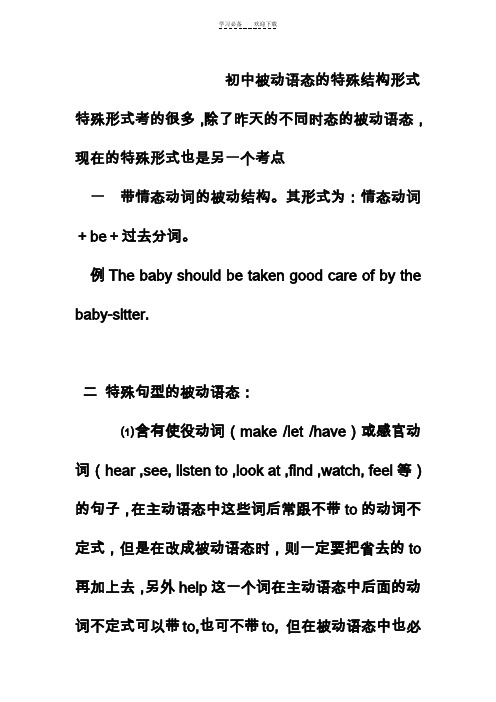
初中被动语态的特殊结构形式特殊形式考的很多,除了昨天的不同时态的被动语态,现在的特殊形式也是另一个考点一带情态动词的被动结构。
其形式为:情态动词+be+过去分词。
例The baby should be taken good care of by the baby-sitter.二特殊句型的被动语态:⑴含有使役动词(make /let /have)或感官动词(hear ,see, listen to ,look at ,find ,watch, feel等)的句子,在主动语态中这些词后常跟不带to的动词不定式,但是在改成被动语态时,则一定要把省去的to 再加上去,另外help这一个词在主动语态中后面的动词不定式可以带to,也可不带to, 但在被动语态中也必须把to加上去。
例:①Mother often makes me do some housework.→I am often made to do some housework by mother.②We saw him run into the classroom.→He was seen to run into the classroom by us.⑵teach ,give ,pass ,show ,buy, tell等动词常常带有两个宾语(双宾语:直接宾语和间接宾语),改为被动语态时,两个宾语可以选其中任一个作主语。
如果直接宾语被提前作主语,那么间接宾语(一般是人)前要加相应的介词to/for。
例:①She gave me a pen.= She gave a pen to me.→I was given a pen by her.→A pen was given to me by her.②My father bought me a new bike.= My father bought a new bike for me.→I was bought a new bike by my father.→A new bike was bought for me by my father.⑶由不及物动词(vi)+介词/副词+宾语的句子改成被动语态时,介词或副词不能丢掉。
被动语态重点知识点总结

被动语态复习“三步曲”被动语态是动词语态的一种形式,表示主语是动作的承受者。
在历年的中考题中,都有一定数量的考查被动语态的题目。
因此,有必要对被动语态进行系统复习。
第一曲:掌握被动语态的结构被动语态由"助动词+及物动词的过去分词"构成。
不同时态的被动语态的差异主要体现在助动词be的变化上,同时助动词be还要在人称和数上与主语保持一致。
现将初中阶段常见的几种时态的被动语态总结如下:1.一般现在时的被动语态:am/is/are+done(指及物动词的过去分词,下同)如:English is used all over the world.2.一般过去时的被动语态:was/were+done如: The picture was painted two years ago.3.现在进行时的被动语态:am/is/are+being+done如: The flowers are being watered by them now.4.现在完成时的被动语态:have(has)+been+done如:The room has been cleaned.5.一般将来时的被动语态:will/be going to+be+done如:The work will be finished tomorrow.6.含有情态动词的被动语态:情态动词+be+done如:Your homework must be handed in today.其它几种特殊句型:It is said that …….. It is well known that ……. It is reported that……..have sth done第二曲:掌握主动语态变被动语态的方法把主动语态变为被动语态时,应走好以下三步:1)主动语态的宾语变为被动语态的主语; 2)主动语态的谓语动词由主动语态形式变为被动语态形式; 3)主动结构的主语变为介词by的宾语,组成介词短语,放在被动结构的谓语动词之后。
被动语态的句型
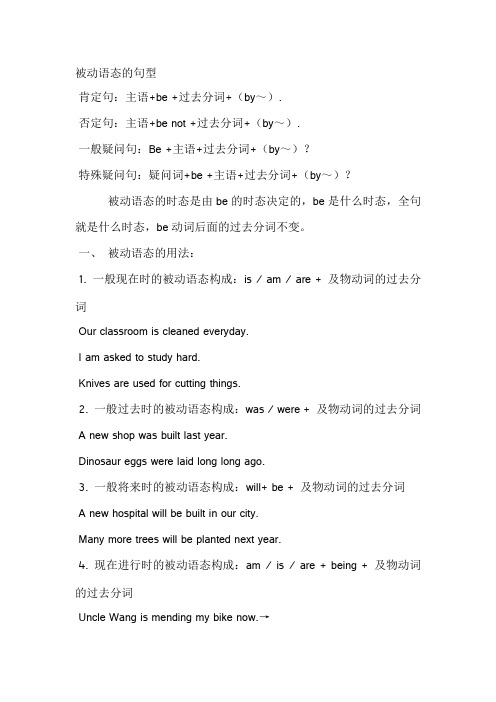
被动语态的句型肯定句:主语+be +过去分词+(by~).否定句:主语+be not +过去分词+(by~).一般疑问句:Be +主语+过去分词+(by~)?特殊疑问句:疑问词+be +主语+过去分词+(by~)?被动语态的时态是由be的时态决定的,be是什么时态,全句就是什么时态,be动词后面的过去分词不变。
一、被动语态的用法:1. 一般现在时的被动语态构成:is / am / are + 及物动词的过去分词Our classroom is cleaned everyday.I am asked to study hard.Knives are used for cutting things.2. 一般过去时的被动语态构成:was / were + 及物动词的过去分词A new shop was built last year.Dinosaur eggs were laid long long ago.3. 一般将来时的被动语态构成:will+ be + 及物动词的过去分词A new hospital will be built in our city.Many more trees will be planted next year.4. 现在进行时的被动语态构成:am / is / are + being + 及物动词的过去分词Uncle Wang is mending my bike now.→My bike is being repaired by Tom now.They are planting trees over there. →Trees are being planted over there by them.5. 现在完成时的被动语态构成:has / have + been + 及物动词的过去分词This book has been translated into many languages.Many man-made satellites have been sent up into space by many countries.6.过去进行时的被动语态构成:was/were + being + 及物动词的过去分词The boy was being operated on when his parents hurried to the hospital. The new road was being made.7.过去完成时的被动语态构成:had + been + 及物动词的过去分词The classroom hadn’t been cleaned before the teacher came.The tickets had been sold out berore I came to the cinema.8.将来完成时的被动语态构成:shall/will + have doneThey will have been married for 20 years by then.The project will have been completed before May.9.含有情态动词的被动语态构成:情态动词+ be + 及物动词的过去分词Young trees must be watered often.Your mistakes should be corrected right now.The door may be locked inside.Your homework can be handed in tomorrow.将下列句子变为被动语态,每空一词:1.We can finish the work in two days.The work ________ _________ _________ in two days.2. They produce silk in Suzhou.Silk _________ _________ in Suzhou.3. The children will sing an English song.An English song ________ _________ ________ by the children.4. You needn't do it now. It _________ _________ _________ by you now.5. Lucy sent me a New Year Card last week. A New Year Card _____ ____ _________ ________ me by her last week.6. Peole use metal for making machines. Metal _________ _______ for making machines.7. He made me do that for him.I _________ ________ ________ _________ that for him.8.I have given this book to the library.This book _______ ________ ________ to the library.9.Did they build a bridge here a year ago?________ a bridge _________ here by them a year ago?10.We'll put on an English play in our school.An English play _________ __________ ___________ on in our sc hool.11.More and more farmers buy colour TV sets.Colour TV sets _________ __________ __________ more and m ore farmers.12.My brother often mends his watch.His watch __________ __________ _________ by my brother.13.We must water the flowers every day.The flowers must ________ _________ (by us) every day. 14.They use knives for cutting things.Knives _________ _________ for cutting things.15.He made the farmers work for a long time.The farmers _________ _________ __________ _________ fora long time.16.Did he break the window yesterday?________ the window _________ __________ __________ yest erday?17.They have sold out the light green dresses.The light green dresses __________ __________ __________ out.18.We clean the classroom every day.The classroom _________ _________ every day.19. You must not plant trees in very dry earth.Trees _________ _________ __________ __________ in very dry earth.20.You can dig a hole in the earth.A Hole _________ __________ __________ in the earth.1. can be finished2. is produced3. will be sung4. needn‘t be done5. was sent to6. is used7. was made to do8. has been given9. Was, built 10. will be put 11. are bought by 12. is often mended13. be watered 14. are used 15. were made to work 16. Wa s, broken by him 17. have been sold 18. are cleaned 19. must not be planted 20. can be dug。
被动语态
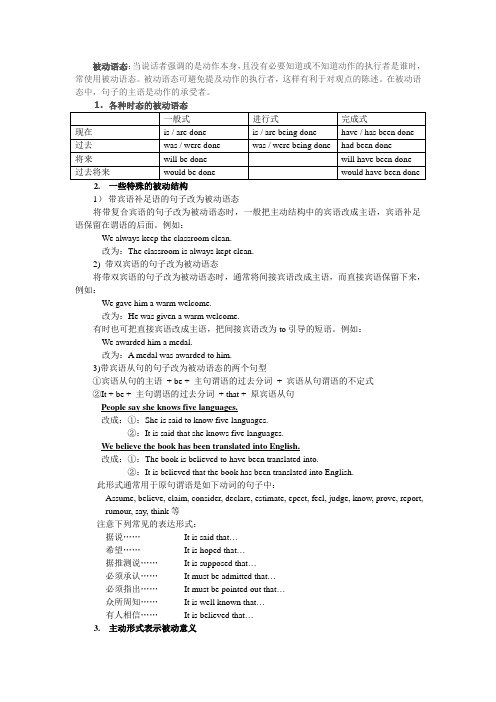
被动语态:当说话者强调的是动作本身,且没有必要知道或不知道动作的执行者是谁时,常使用被动语态。
被动语态可避免提及动作的执行者,这样有利于对观点的陈述。
在被动语态中,句子的主语是动作的承受者。
1)带宾语补足语的句子改为被动语态将带复合宾语的句子改为被动语态时,一般把主动结构中的宾语改成主语,宾语补足语保留在谓语的后面。
例如:We always keep the classroom clean.改为:The classroom is always kept clean.2) 带双宾语的句子改为被动语态将带双宾语的句子改为被动语态时,通常将间接宾语改成主语,而直接宾语保留下来,例如:We gave him a warm welcome.改为:He was given a warm welcome.有时也可把直接宾语改成主语,把间接宾语改为to引导的短语。
例如:We awarded him a medal.改为:A medal was awarded to him.3)带宾语从句的句子改为被动语态的两个句型①宾语从句的主语+ be + 主句谓语的过去分词+ 宾语从句谓语的不定式②It + be + 主句谓语的过去分词+ that + 原宾语从句People say she knows five languages.改成:①:She is said to know five languages.②:It is said that she knows five languages.We believe the book has been translated into English.改成:①:The book is believed to have been translated into.②:It is believed that the book has been translated into English.此形式通常用于原句谓语是如下动词的句子中:Assume, believe, claim, consider, declare, estimate, epect, feel, judge, know, prove, report, rumour, say, think等注意下列常见的表达形式:据说……It is said that…希望……It is hoped that…据推测说……It is supposed that…必须承认……It must be admitted that…必须指出……It must be pointed out that…众所周知……It is well known that…有人相信……It is believed that…3.主动形式表示被动意义1)动词want, need, require, deserve后用动名词的主动形式,这时,动名词同句中的主语有动宾关系。
被动语态定语从句
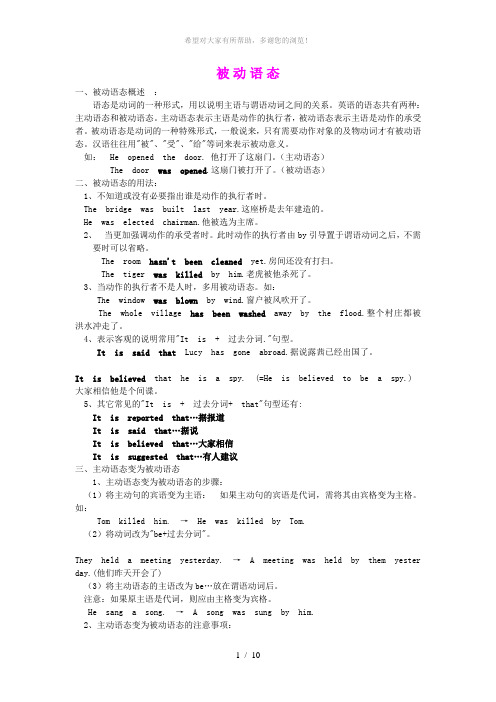
被动语态一、被动语态概述:语态是动词的一种形式,用以说明主语与谓语动词之间的关系。
英语的语态共有两种:主动语态和被动语态。
主动语态表示主语是动作的执行者,被动语态表示主语是动作的承受者。
被动语态是动词的一种特殊形式,一般说来,只有需要动作对象的及物动词才有被动语态。
汉语往往用"被"、"受"、"给"等词来表示被动意义。
如:He opened the door. 他打开了这扇门。
(主动语态)The door was opened.这扇门被打开了。
(被动语态)二、被动语态的用法:1、不知道或没有必要指出谁是动作的执行者时。
The bridge was built last year.这座桥是去年建造的。
He was elected chairman.他被选为主席。
2、当更加强调动作的承受者时。
此时动作的执行者由by引导置于谓语动词之后,不需要时可以省略。
The room hasn't been cleaned yet.房间还没有打扫。
The tiger was killed by him.老虎被他杀死了。
3、当动作的执行者不是人时,多用被动语态。
如:The window was blown by wind.窗户被风吹开了。
The whole village has been washed away by the flood.整个村庄都被洪水冲走了。
4、表示客观的说明常用"It is + 过去分词."句型。
It is said that Lucy has gone abroad.据说露茜已经出国了。
It is believed that he is a spy. (=He is believed to be a spy.)大家相信他是个间谍。
5、其它常见的"It is + 过去分词+ that"句型还有:It is reported that…据报道It is said that…据说It is believed that…大家相信It is suggested that…有人建议三、主动语态变为被动语态1、主动语态变为被动语态的步骤:(1)将主动句的宾语变为主语:如果主动句的宾语是代词,需将其由宾格变为主格。
初中语法被动语态讲解

初中语法被动语态讲解被动语态定义:英语中有两重语态:主动语态和被动语态。
主动语态中的主语是动作的执行者,被动语态中的主语是动作的承受者,即主动语态中的宾语。
所以只有及物动词才有被动语态。
规则:被动语态由“助动词be+及物动词的过去分词”构成。
第一,助动词be 要随着人称和数的变化而变化,第二,助动词be要随着时态的变化而变化。
一、被动语态的构成形式1. 被动语态的基本时态变化以do为例,各种时态的被动语态形式为:1) am/is/are +done (过去分词) 一般现在时例Visitors are requested not to touch the exhibits.2) was/were done 一般过去时例I was given ten minutes to decide whether I should reject the offer.3) shall/will be done 一般将来时例Hundreds of jobs will be lost if the factory closes.4) am/is /are being done 现在进行时例A new cinema is being built here(5) was/were being done 过去进行时例A meeting was being held when I was there.6) should/would be done 过去将来时例The news would be sent to the soldier's mother as soon as it arrived.7) has /have been done 现在完成时例All the preparations for the task have been completed, and we're ready tostart.8) had been done 过去完成时例 By the end of last year, another new gymnasium had been completed inBeijing.9) shall/will have been done 将来完成时(少用)例The project will have been completed before July.2(被动语态句型变化肯定句主语+be+过去分词+(by …)否定句主语+be not+过去分词+(by …)一般疑问句 Be+主语+过去分词+(by …)?特殊疑问句疑问词+be+主语+过去分词+ (by …),3. 被动语态的特殊形式1) 带情态动词的被动结构。
初中知识点归纳被动语态的特殊用法与句型转换
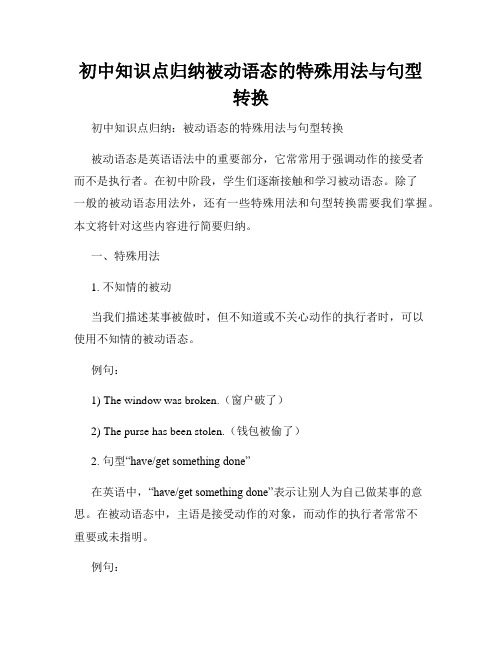
初中知识点归纳被动语态的特殊用法与句型转换初中知识点归纳:被动语态的特殊用法与句型转换被动语态是英语语法中的重要部分,它常常用于强调动作的接受者而不是执行者。
在初中阶段,学生们逐渐接触和学习被动语态。
除了一般的被动语态用法外,还有一些特殊用法和句型转换需要我们掌握。
本文将针对这些内容进行简要归纳。
一、特殊用法1. 不知情的被动当我们描述某事被做时,但不知道或不关心动作的执行者时,可以使用不知情的被动语态。
例句:1) The window was broken.(窗户破了)2) The purse has been stolen.(钱包被偷了)2. 句型“have/get something done”在英语中,“have/get something done”表示让别人为自己做某事的意思。
在被动语态中,主语是接受动作的对象,而动作的执行者常常不重要或未指明。
例句:1) I had my hair cut.(我理了发)2) She got her car repaired.(她让人修了车)3. 句型“be to blame for”当我们想表达某事是由某人负责或应该为其负责时,可以使用“be to blame for”这一被动语态句型。
例句:1) He is to blame for the accident.(他应为这次事故负责)2) They were to blame for the delay.(他们应对耽搁负责)二、句型转换1. 主动句变被动句将主动句转换为被动句时,需要注意以下几点:1) 主语变为被动语态的主语;2) 动词使用被动形式(be+过去分词);3) 如果主动句中有宾语,需要将其变为被动语态句中的主语。
例句:1) 主动句:They build bridges.(他们建桥)被动句:Bridges are built by them.(桥被他们建造)2. 被动句变主动句将被动句转换为主动句时,可以根据以下步骤进行:1) 被动语态的主语变为主动语态的宾语;2) 被动语态的谓语动词变为主动语态的谓语动词;3) 被动语态的宾语变为主动语态的主语。
九年义务初中英语被动语态重点知识点大全
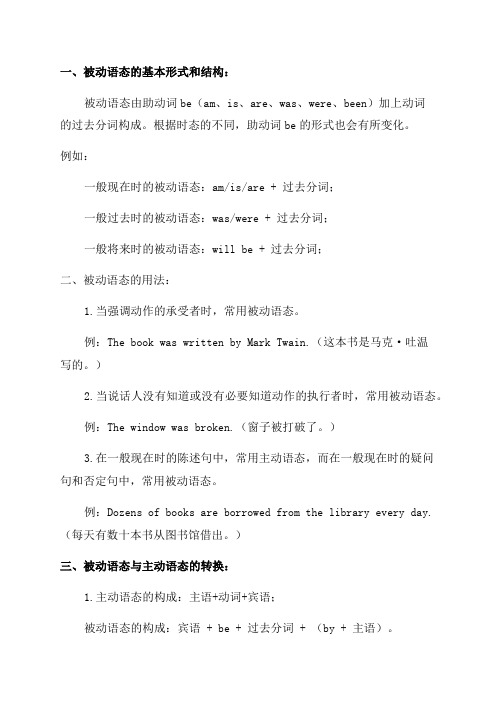
一、被动语态的基本形式和结构:被动语态由助动词be(am、is、are、was、were、been)加上动词的过去分词构成。
根据时态的不同,助动词be的形式也会有所变化。
例如:一般现在时的被动语态:am/is/are + 过去分词;一般过去时的被动语态:was/were + 过去分词;一般将来时的被动语态:will be + 过去分词;二、被动语态的用法:1.当强调动作的承受者时,常用被动语态。
例:The book was written by Mark Twain.(这本书是马克·吐温写的。
)2.当说话人没有知道或没有必要知道动作的执行者时,常用被动语态。
例:The window was broken.(窗子被打破了。
)3.在一般现在时的陈述句中,常用主动语态,而在一般现在时的疑问句和否定句中,常用被动语态。
例:Dozens of books are borrowed from the library every day.(每天有数十本书从图书馆借出。
)三、被动语态与主动语态的转换:1.主动语态的构成:主语+动词+宾语;被动语态的构成:宾语 + be + 过去分词 + (by + 主语)。
例如:主动语态:He wrote a letter yesterday.(昨天他写了一封信。
)被动语态:A letter was written by him yesterday.(昨天一封信被他写了。
)2.被动语态转换的注意事项:a.如果主动句中的宾语是由人称代词构成的,可以直接将其改为被动句的主语。
b.如果主动句中有间接宾语和直接宾语,将间接宾语变为被动句的主语,直接宾语保持不变。
c. 如果主动句中的宾语是由关系代词who或which引导的从句,常省略by短语。
例如:主动语态:They built a new school in our village.(他们在我们村修建了一所新学校。
)被动语态:A new school was built in our village by them.(在我们村有一所新学校被他们修建了。
- 1、下载文档前请自行甄别文档内容的完整性,平台不提供额外的编辑、内容补充、找答案等附加服务。
- 2、"仅部分预览"的文档,不可在线预览部分如存在完整性等问题,可反馈申请退款(可完整预览的文档不适用该条件!)。
- 3、如文档侵犯您的权益,请联系客服反馈,我们会尽快为您处理(人工客服工作时间:9:00-18:30)。
初中被动语态的特殊结构形式特殊形式考的很多,除了昨天的不同时态的被动语态,现在的特殊形式也是另一个考点一带情态动词的被动结构。
其形式为:情态动词+be+过去分词。
例The baby should be taken good care of by the baby-sitter.二特殊句型的被动语态:⑴含有使役动词(make /let /have)或感官动词(hear ,see, listen to ,look at ,find ,watch, feel等)的句子,在主动语态中这些词后常跟不带to的动词不定式,但是在改成被动语态时,则一定要把省去的to再加上去,另外help这一个词在主动语态中后面的动词不定式可以带to,也可不带to, 但在被动语态中也必须把to加上去。
例:①Mother often makes me do some housework.→I am often made to do some housework by mother.②We saw him run into the classroom.→He was seen to run into the classroom by us.⑵teach ,give ,pass ,show ,buy, tell等动词常常带有两个宾语(双宾语:直接宾语和间接宾语),改为被动语态时,两个宾语可以选其中任一个作主语。
如果直接宾语被提前作主语,那么间接宾语(一般是人)前要加相应的介词to/for。
例:①She gave me a pen.= She gave a pen to me.页脚内容1→I was given a pen by her.→A pen was given to me by her.②My father bought me a new bike.= My father bought a new bike for me.→I was bought a new bike by my father.→A new bike was bought for me by my father.⑶由不及物动词(vi)+介词/副词+宾语的句子改成被动语态时,介词或副词不能丢掉。
(前面已举过两例)例:①We should speak to old people politely.→Old people should be spoken to politely ( by us).②He took away the box..→The box was taken away by him.⑷含有宾语补足语的句子改为变动语态。
(宾补放在原来位置不变)例:①We call him Xiao Ma.主谓宾宾补→He is called Xiao Ma by us.②He found the book very interesting.→The book was found very interesting by him.页脚内容2三、It is said that+从句及其他类似句型一些表示“据说”或“相信”的动词如believe, consider, expect, report, say, suppose, think等可以用于句型“It+be+过去分词+that从句”或“主语+be+过去分词+to do sth.”。
有:It is said that… 据说,It is reported that…据报道,It is believed that…大家相信,It is hoped that…大家希望,It is well known that…众所周知,It is thought that…大家认为,It is suggested that…据建议。
例It is said that the boy has passed the national exam. (=The boy is said to have passed the national exam. )四没有被动语态的动词:1. 没有被动语态的词,表示状态或特征的及物动词如cost, fit, have, suit, write well(好写),sell well(好卖)等没有被动形式,另外,诸如happen = take place, break out(爆发),break down(坏了) 等不及物动词或短语以及诸如result from(缘于),belong to,等只用主动语态,而不用被动语态2不及物动词或动词短语无被动语态: appear,die ,disappear, end (vi. 结束), fail, last(持续), lie, remain, sit, spread(传播), stand, come true, fall asleep, ...3.大多数系动词:be , feel (摸起来),sound(听起来),look(看起来),smell(闻起来) taste(尝起来)等词无被动语态,它们的主动形式表示被动意义。
例:①The skirt feels very soft. 这件裙子摸起来很柔软。
②Many changes have happened in our hometown.③The film lasted for 3 months页脚内容3语法专练一、把下列主动语态改为被动语态:1. We often use a recorder in our English class._______________________________________________________________________________.2. They will show a new film next week._______________________________________________________________________________.3. I saw the boy enter the room._________________________________________________________________________.4. We often see him help his classmate._______________________________________________________________________________.5. You must turn off the light before you go to bed.______________________________________________________________________________.二、选择填空:1. The reading room ________ yesterday afternoon.A. cleanedB. is cleanedC. was cleaningD. was cleaned2. The workers were made ________ ten hours a day.页脚内容4A. workB. to workC. workingD. worked3. Food ________ in a cool place in summer.A. must keepB. mustn’t keepC. must be keptD. mustn’t be kept4. The pen ________ well.A. writesB. is writtenC. was writtenD. writing5. Great changes ________ in the town since 1988.A. have taken placeB. have been taken placeC. has taken placeD. has been taken place6. Our compositions must ________ next Monday.A. be hand inB. be handed inC. handed inD. be handing in7. The child will ________ back to his parents next month.A. sentB. sendC. be sentD. be sending8. The classroom ________ nowA. is cleaningB. is being cleaningC. is being cleanedD. is cleaned9. No permission允许has ________ for anybody to enter the building.A. been givenB. givenC. to giveD. be given页脚内容510. I _______ ten minutes to decide whether I should reject the offer.A. gaveB. was givenC. was givingD. had given11. Can such a thing _____ happening again?A. prevent fromB. prevented fromC. be prevented fromD. to prevent from12. A new house ________ at the corner of the road.A. is buildingB. is being builtC. been builtD. be building三、用适当时态和语态的动词填空: 用一个或几个单词1. Can he ________ (speak) English?2. What language ________ (speak) in that country?3. The film ________ (show) many times since last Sunday.4. These TV sets ________ (make) in Sichuan.5. It has got so dark. Would you please ________ (turn) on the light?6. A new hospital ________ (build) in this area now.7 . I ________ (tell) that he ________ (not come) just now.页脚内容6。
